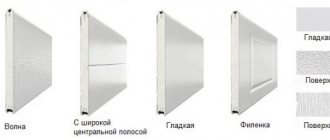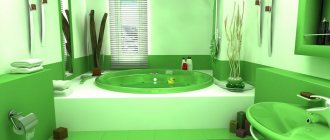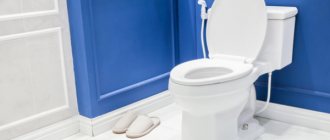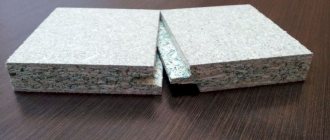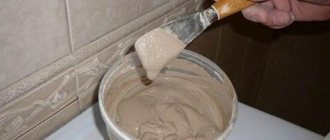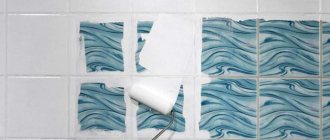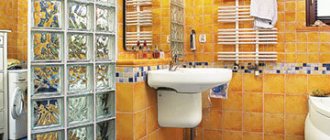Grouting the tile joints in the bathroom with your own hands is done at the last stage of finishing work. A small number of tools are used to apply the mortar to the joint areas of the tile covering, which simplifies installation. Considering that such cladding is often performed in rooms where the level of humidity is high, the compositions used must be moisture resistant.
Grouting is performed at the last stage of finishing work.
Types of grout based on material of manufacture
Solutions are divided into groups based on the amount of active ingredients: one- and two-component. In addition, materials are distinguished by shade: colored and colorless. Substances with different properties are used in the form of active components: polymers, cement, resins. Each option differs in the degree of resistance to mechanical stress, moisture, chemicals and high temperatures.
Cement
The main component is cement. Materials in this group differ in the amount of active substances.
Cement grout for joints.
The following types of grout are distinguished:
- with sand;
- no sand.
Additionally, additives are used to ensure frost resistance and moisture resistance. The composition determines the operational properties: seam thickness, resistance to cracking, etc.
Advantages:
- high hardness;
- the ability to fill seams with a minimum width of up to 5 mm;
- properties can be improved by adding various components to cement: the presence of sand in the composition allows the material to be used to protect wide joints;
- cement putties are easy to apply;
- no negative impact on the tiles;
- abrasion resistance under moderate use;
- thanks to pigments, it is possible to choose the desired color to fill the joints on the floor and walls between the tiles.
The materials of this group last a long time.
Cement grout (fugue) also has many disadvantages:
- with prolonged contact with water, part of the liquid will be absorbed into the structure of the material, which will gradually lead to a deterioration of its properties;
- insufficient strength due to the low elasticity of the grout, this problem is partially solved thanks to special additives;
- with intensive use of the coating, the cement grout is subject to abrasion;
- over time, the fugue filling the space between the tile joints cracks, which leads to a reduction in the service life of the tile cladding;
- exposure to aggressive chemicals.
Hydrophobic grout.
To make moisture-resistant grout, hydrophobic compounds are used. To increase resistance to fungus, antiseptic additives are used. There are different types of cement grout depending on the area of application. For example, to protect the narrowest cracks, you can use a cement fugue without sand. This reduces its hardness and resistance to cracking.
Seams up to 1 cm wide are filled with cement-sand mixtures. As a result, cracks will not form under the influence of tensile and compression loads.
Cement fugue is available in the form of a ready-made mixture that does not need to be diluted; just open the container and you can start working. Dry powder for making grout yourself is also available on sale.
Its disadvantage is that the ratio of the components must be maintained, otherwise the material will lose its properties and the seams between the tiles will quickly collapse.
Epoxy
This type of grout performs a protective and decorative function. It belongs to the group of two-component materials. The main substance is epoxy resin, but it acquires the desired properties only in combination with a hardener. These components are produced in separate containers.
This need is due to the fact that when epoxy resin and hardener are combined, a chemical reaction immediately occurs, resulting in the formation of a high-strength polymer material.
The composition does not include cement, which eliminates the risk of water penetration into the structure of the epoxy grout. This increases the service life of the material. The excellent properties of this fugue are due to the almost complete absence of pores.
Epoxy grout for tiles.
As a result, a number of advantages are provided:
- high strength;
- moisture resistance;
- vapor tightness;
- resistance to aggressive chemicals;
- long service;
- resistance to cracking;
- versatility of use;
- resistance to abrasion during intensive use of the coating;
- epoxy resin fills seams from 1 to 15 mm;
- the material does not require maintenance;
- has antifungal properties;
- withstands temperatures within -20…+100°С;
- hypoallergenic;
- no shrinkage during drying;
- Epoxy resin can be used as an adhesive and grout.
There are also disadvantages. Note the complexity of the work. Mixing and application require skill as the composition polymerizes quickly. You will have to prepare the grout yourself, and to do it correctly, you need to use special tools. The price of the material is higher compared to cement fugue. If you need to replace the grout, it will be difficult to do so: you will have to remove it along with the ceramic tiles.
Polyurethane
The main difference between this material and other types is elasticity. Polyurethane does not absorb moisture, but can withstand tensile and tensile loads, which is due to its special structure.
Despite this, the grout is designed to fill joints from 1 to 5 mm. The reason is that the strength is not high enough. If polyurethane grout is used to protect wider joints, even low movement of the tiles can cause the material to fail.
Positive traits:
- low hardening rate, this allows you to eliminate all defects formed during operation;
- plastic;
- moisture resistance;
- the material is ready for use;
- ease of cleaning the tiles if there is mortar left on them;
- the seam does not crack;
- resistance to most aggressive substances.
The polyurethane composition has few disadvantages: high price, inability to fill wide seams with such material. In addition, this type of grout mixture does not tolerate exposure to chlorine.
Silicone
Performs the functions of a sealant. The material is universal; it is used for grouting tile joints, corner joints, and leaks when laying communications. This is a ready-made composition, after opening the container it can be used. Hydrophobic and antiseptic additives are not needed, since the product exhibits such properties. Silicone grout belongs to the group of one-component mixtures.
Silicone sealant for tile joints.
Most often, the material of this group is used in rooms with high levels of humidity.
Its advantages:
- water resistance;
- elasticity;
- ability to withstand tensile and compressive loads;
- safety for people;
- ease of use;
- ease of cleaning the tiles in the event that silicone gets on the lining.
However, the low strength of this composition is noted, so it is recommended to use it in complex, hard-to-reach areas. On surfaces that are subject to heavy loads, silicone is applied only in combination with more durable grouts. The disadvantage is the small number of options that differ in color: the silicone product can be purchased either white or transparent.
Latex
It is characterized by high ductility, therefore it can withstand temperature changes, the effects of tensile and tensile loads.
The advantages of such mixtures:
- Can be used for filling wide joints - up to 30 mm;
- they use the material to protect the external joints of tiles, since it can withstand the influence of extreme temperatures, ultraviolet radiation, and moisture;
- resistance to cracking;
- wide selection of colors.
Latex mixtures have few disadvantages. They note the need to quickly complete the work, since if the tiles become dirty, a cloudy film may remain on its surface after removing the grout. Despite its good tolerance to high temperatures, latex loses its properties if it is exposed to hot steam.
Furanic
The material contains resin. Latex is also used in production - this component helps to increase the plasticity of the mixture. Portland cement is sometimes added to increase the strength of the material. Such mixtures are not recommended for indoor use, as they react to certain chemicals. Furan grout is only resistant to acids. In addition, it is only sold in black.
Furan grout.
It is recommended to use this type of resin-based material in industrial premises. Thanks to the ability to withstand the influence of intense loads, tile joints will be well protected for a long period. This material is not sold in construction stores; it is made to order for large companies.
What is grout
Anyone who has studied it even a little knows about the richness of the Russian language. The diversity is also confirmed by the morphological analysis of the word grout. Dictionaries give several interpretations:
- flour porridge;
- last plastering operation;
- a special mixture for sealing joints between laid tiles. Another term is sometimes used: "fugue".
We are interested in the latter explanation. A more complete version of the interpretation of the concept is as follows: grout is a whole group of building materials for filling the gaps between tiles.
The essence of the technical process is to fill the free space between the laid cladding with a plastic mass, which is glued to the edges of the tile, after which it hardens during the setting or drying process. As a result, a waterproof partition is formed that protects the tile adhesive from moisture. At the same time, the fugue does not shrink during the hardening process thanks to special additives. No shrinkage, no cracks.
The goal is to completely seal the installation.
Functions
The fugue performs several important functions:
- protects the seams between tiles from moisture and dirt;
- masks defects in facing material;
- strengthens the masonry, extending the service life of the cladding;
- prevents the development of pathogenic microflora (mold, fungus);
- gives completeness to the laid ceramics, covering gaps in joints and giving an additional decorative effect to the facing material.
How to calculate the amount of grout
To calculate the volume of grout, take the manufacturer's recommendations, which can be found on the label. However, in this case, averaged data is used, since it is difficult to provide for all possible factors: the use of tiles of different sizes, taking into account joints of different widths. It is recommended to purchase material with a reserve of 15-20% of the total volume. This will cover the seams for which the main amount of the composition is not enough.
If you need to more accurately calculate the volume of grout, you should use tables compiled by specialists.
To do this, you will need to take measurements of the tiles and determine the sufficient width of the seam between the products. Based on such data, you can find out the consumption of the grout mixture (kg/m²). If the table does not contain the required tile sizes, you can independently determine the approximate material consumption, based on values that are as close as possible to the calculated values.
Can I use grout instead of putty?
Before answering this question, it is necessary to understand the fundamental differences between grout and putty. The grout is used primarily to fill joints; it should penetrate well into all cavities and set quickly in a narrow space. The putty is intended only for leveling surfaces for painting or wallpapering.
The putty will turn out even and smooth only if it is applied in a thin but wide layer. If you fill seams with it in several layers, the surface will become covered with cracks. With grout, the opposite is true - its thin layer quickly cracks, but the thick one remains intact and smooth. Therefore, in fact, both of these solutions cannot be interchangeable due to functional differences.
But some craftsmen claim that grout can be turned into putty. To do this, you need to add any moisture-retaining component to its composition, for example, methylcellulose.
With putty, everything is different - it needs to be given moisture-repellent properties by mixing with oil paint or glue. But the builder must conduct such experiments at his own peril and risk, since there are no such instructions in the instructions for the tools.
It is allowed to clean and prime the seams only 12 hours after applying the grout.
How to choose the right grout composition
The purpose of the mixture is determined: there are materials with increased wear resistance for floors, walls (less durable), for filling joints outdoors or indoors. Take into account the composition of the grout.
In this case, it is necessary to pay attention to the operating conditions:
- likelihood of contact with moisture, steam;
- exposure to high temperatures;
- the intensity of the applied mechanical load: tensile, tensile, compressive, impact;
- exposure to chemicals;
- exposure to ultraviolet radiation.
The tone of the material must be taken into account. If it is neutral (a gray substance, as is the case with cement grouts), pigment will need to be introduced at the preparation stage. The product is selected taking into account the color of the tiles, as well as the palette in which the room is decorated.
Possible options:
- seams of the same shade with tiled cladding;
- Contrasting materials are used to create an accent in the interior.
To choose the right color, you can look at photos of various designs.
Applying grout to decorative stone
For this type of cladding, cement-based materials are used. There are some subtleties in grouting decorative artificial granite. A distinctive feature of this material is its relief surface. Having penetrated into the stone, the grout mixture is washed off very poorly and remains in its pores for a long time. In addition to the insulating function, the intervals between the ends of the cladding also have a decorative function. Artificial granite tiles are covered with brick or stone jointing. Therefore, the technology for performing such activities is somewhat different than simple grouting of ceramic tiles.
To finish artificial decorative granite, it is recommended to use a grout gun or a cone-shaped bag. After cleaning the granite from dust and dirt resulting from installation, you need to prepare a working solution and fill the syringe with it. Then you need to carefully fill the entire space with the mixture; there should be no voids or irregularities between the tiles. It is important not to stain the stone or brick itself. It is most inconvenient to cover seams in corners. Therefore, so as not to have to adapt to them every time, it is better to start working correctly with them, filling the space between the tiles from top to bottom. If the solution gets on a brick, it must be removed from the surface immediately.
Applying grout to decorative stone
It is highly undesirable to cover the seams of the decorative coating with a spatula. As a result of such actions, not only will the surface become dirty, but the seal will also be broken, which is undesirable when using drywall.
When the grout dries a little (after about 20-30 minutes), smoothing and jointing of the brick cladding is carried out. To do this, you can use a spatula or a special spatula. After the tiles are completely dry, use a medium-hard brush to remove all remaining grout.
As you can see, creating a decorative interior in a bathroom from tiles and plasterboard, laying out the cladding to look like brick or stone, and grouting the tile joints with your own hands is not too tricky. Doing this work yourself will allow you to save money, gain practical skills and knowledge, become a tile master, and then enjoy the result for many years.
Do-it-yourself grouting technology
If mistakes are made when filling the joints between tiles, the service life of the coating will be reduced. The seams crack, and moisture penetrates into the adhesive structure under the tile, which leads to the destruction of the cladding.
Tools for work
You will need:
- rubber spatula;
- container for preparing the solution;
- notched spatulas of different sizes;
- stitcher - for forming seams;
- sponge;
- rags.
You need to work with gloves. If you prepare the mixture for filling joints yourself, you should use glasses and a respirator.
Surface preparation
Work begins 2-3 days after laying the tiles. During this time the glue will dry. If you need to meet the deadlines in a shorter time, it is permissible to start grouting the joints after 1 day. The mixture is applied to the joints between the tiles only if the surface is prepared: cleaned and dried. There should be no glue left on it. It will be much more difficult to remove it after it dries, so the tiles need to be cleaned as they are laid.
When grout mixtures containing pigments are used, it is recommended that before starting work, a special composition is applied that protects the cladding from staining. Thanks to it, a film is formed over the pores of the ceramic coating. After treatment with this material, grouting can be done after 2 hours. The composition is especially often used for white tiles. This product is not applied to glass and polymer cladding.
Grout with pigment.
Preparation of working solution
It is necessary to fill the seams in areas of no more than 1 m², moving around the room. If you prepare the solution in a large volume, it will quickly harden and it will be impossible to work with it. In this case, you will have to knead the fugu again.
First, water is poured into the container in a small amount, then dry ingredients are added in accordance with the instructions. The solution is stirred with a small spatula, and the remaining amount of water is poured in a thin stream. In this case, you need to constantly stir the fugu. You should leave the finished mixture for 8-10 minutes, and you can start working.
Applying grout
The solution is spread over the seams using a rubber spatula. The recommended tilt angle is 30°. It is necessary to apply moderate pressure on the spatula, trying to fill the seam along the entire height and width. Cement grout is applied after the surface is moistened, this ensures high adhesion.
Method of applying grout.
Sealing
In rooms with high humidity levels, another type of grout is used - silicone material. It is applied over finished seams. This is done to ensure protection of the coating from water.
Wet surface cleaning
Excess grout should be removed no earlier than after 20 minutes. This time is enough so that the seams are not damaged, but at this stage the fugue can be easily cleaned off. For this purpose, use a moistened sponge. Final cleaning of the coating is performed when the material has hardened. In this case, you need to moisten the entire surface, then wipe it dry.
Dry cleaning
This method should be used at the initial stage of drying the grout mixture. While the material is still wet, its contact with drops of water can lead to loss of properties. Use a dry cloth to remove excess solution immediately after application. In this case, you must first remove the mixture with a flexible spatula. Then the surface is cleaned with a cloth.
Preparatory work
Before grouting the seams on the tiles, it is necessary to clean the tile coverings from any remaining dirt or adhesive materials. The procedure can be performed with a metal spatula or a stationery knife, but this should be done with extreme caution so as not to damage the glossy edge of the ceramic. After cleaning, it is necessary to moisten the seams with water. This is necessary so that the working solution “shrinks” less. The procedure can be performed with a sprayer, a sprayer or a regular sponge. It is advisable to cover the floor with cardboard or polyethylene.
When the surface is prepared, you can proceed to preparing the solution. To obtain epoxy grout, you need to mix two components - a resin and a hardener. The result will be a dense, elastic mass. Applying such a solution is not very convenient. Grouting ceramic tiles with epoxy paste is a painful and painstaking task.
Preparation of the solution
When preparing grout, you need to compare two important factors - application time and drying time. If you are working slowly, it is better to cook several small portions at a time
Consistency of finished grout
The grout mixture should be prepared immediately before starting work.
What needs to be done to prevent cracks from appearing
All possible causes of damage must be eliminated:
- mobility of the rough foundation (incorrectly executed cement screed or unstable wooden structure);
- violation of the proportions of the components;
- exposure to water before the solution hardens.
The work is carried out making sure that the base is strong. If there are defects, it must first be repaired, then cladding done. The grout mixture must be viscous, without separate fractions, and have a uniform structure. It is applied to clean, dry surfaces. Further work should be carried out when the fugue is dry.
Set of tools for work
Before diluting the grout, you should prepare a simple set of tools that will help you complete the work quickly and efficiently. The set includes:
- protective equipment for the master - rubber gloves, respirator mask, construction glasses;
- a round container for preparing a liquid mixture;
- putty knife;
- drill with mixer attachment;
- bucket with water;
- soft clean cloth and foam sponge;
- scales or measuring container.
In addition to the grout mixture, it is necessary to prepare a solvent. It can be ordinary clean water or latex - you should follow the instructions of the mixture manufacturer.
The grout is prepared in small portions, designed for 10 minutes of work. The diluted product completely loses its properties 2 hours after mixing.
Making your own grout for joints
You can choose any of the recipes:
- Based on cement and sand. Proportions: 1:1 or 1:2. The amount of water is arbitrary, but you need to get a mixture that resembles sour cream in consistency.
- Alabaster mixture. The powder is taken in any quantity, water is added until the solution becomes viscous. A small amount of material is prepared, since alabaster hardens quickly.
- Gypsum grout. Slaked lime is added to increase strength. For a bathroom, this option is less suitable than others, since the material is not resistant to moisture.
- Clay based. Separately combine lime and cement in a 1:1 ratio. The mixture is added to the kneaded clay. The material must have a uniform structure. The amount of clay, lime and cement is determined taking into account the ratio of 10:1:1.
Homemade gypsum and alabaster grouts do not last long, because they are not durable and moisture resistant. For this reason, they cannot be used for tiling bathroom floors. It is allowed to apply such mixtures to other surfaces; after completion of work, the seams are protected with a moisture-resistant compound.
Features of working with mosaics
Creating a decorative design in the bathroom requires not only a creative approach, but also painstaking work. Mosaic on a plasterboard wall is one of the interesting and original solutions for a bathroom interior (provided that moisture-resistant plasterboard is used). The facing tiles are attached to the base with ordinary tile adhesive. In some cases, technology is used that allows mosaics to be glued directly onto the grout, creating interesting solutions for architectural decoration on the basis of plasterboard. Joining with brick or natural stone gives the bathroom a special uniqueness, but greatly complicates the finishing of the mosaic.
To give your panel a luxurious look, you need to know how to properly finish it. The procedure should be started only after 24 hours after laying the mosaic. Before grouting the tiles, you need to remove any remaining adhesive from the surface. To fill the gaps, use white or colored mixtures (using a latex additive). To work with materials based on epoxy resin, it is convenient to use a construction syringe or a grout bag.
Grouting mosaic joints
When diluting mosaic components, you must strictly adhere to the manufacturer's instructions and recommendations. Apply the solution using rubbing movements horizontally and vertically with a rubber spatula. It also removes all excess mixture (with diagonal movements). The grout dries quickly enough, within 15-20 minutes, so it is better not to cover large areas at a time.
After drying, all errors must be wiped away with a sponge soaked in water. The hardening of the epoxy-based solution is indicated by its appearance - the seams become matte. Mosaic tiles must be cleaned exclusively with a flat sponge. In this case, the mixture will not be washed out of the seams.
Cleaning the surface after work
Wall mosaic spaces should be covered in several stages. In this case, between approaches, you need to give the solution sufficient time to harden. When placing plasterboard-based cladding, the tiles may move during work. You need to correct it with the smooth part of the spatula. This must be done quickly enough. Once the mosaic has set with the glue, it will no longer be possible to correct the errors. The higher the air temperature, the faster the curing time of the epoxy mixture. Therefore, in hot rooms you should not mix large portions of the solution, but they should be produced as quickly as possible.
Sometimes, even during the process of applying the mass, cracks begin to appear. To correct the situation, you need to rub dry powder directly into the cracks that have formed.


